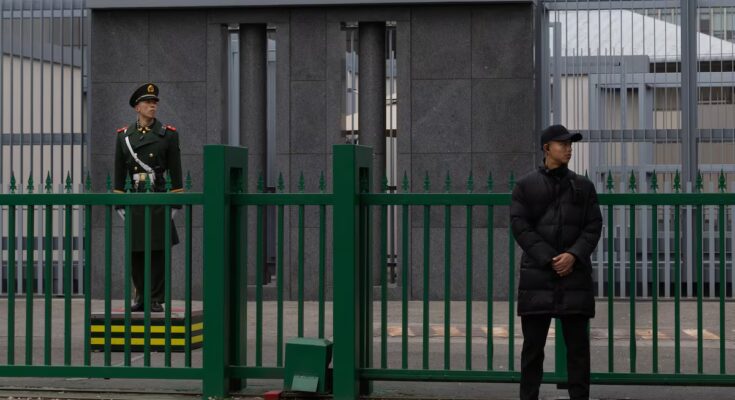Relations between China and Japan have entered their most fragile phase in recent years, following statements by Japanese Prime Minister Sanae Takaichi on the possibility of Tokyo intervening militarily with Washington in the event of Chinese aggression against Taiwan. The tension quickly moved from the verbal to the diplomatic level and, in a week, also to the military level: Beijing imposed a temporary ban on navigation in a part of the Yellow Sea to carry out live-fire maneuvers between Monday and Wednesday, according to a maritime warning broadcast this Saturday by Chinese state media.
In its statement – originally released Wednesday – China’s Maritime Safety Administration offered no details on the nature of the military training or the means or types of weapons they will use. Although this area is located at a great distance from the Japanese archipelago, the coincidence in time with the current diplomatic crisis adds a new level of tension to the already complex bilateral relations.
The immediate origin of the conflict dates back to November 7, when Takaichi declared before the Japanese parliament that China’s use of military force in the Taiwan Strait could be considered “a situation that threatens the survival of Japan”. He added that this scenario would allow the intervention of the Japanese Self-Defense Forces in the framework of collective defense with the United States. The comment represents a departure from the strategy of ambiguity that Tokyo (and also Washington) has been pursuing for years regarding the response to Chinese military action in the region.
Chinese social media was immediately enraged by the claims, blaming Japan for causing the chaos. The brawl worsened when the Chinese consul in Osaka published (and later deleted) a message calling on Takaichi to “cut off his head,” to which Tokyo apologized.
On Monday the 10th a spokesperson for the Chinese Foreign Ministry criticized Taikaichi’s words, calling them “blatant interference in China’s internal affairs”. “What kind of message does the Japanese leader intend to send to the Taiwanese independence forces with these statements?” urged spokesperson Lin Jian. “Where exactly do you want to take Japan in bilateral relations?” he continued. The same day, Takaichi said his statements were “hypothetical.”
However, tension remained throughout the week, with Chinese media linking their comments to a supposed “resurgence of Japanese militarism.”
Chinese Vice Foreign Minister Sun Weidong summoned Japan’s ambassador to China, Kenji Kanasugi, on Thursday, to whom he expressed his deep discontent and rejection of Takaichi’s “extremely incorrect” and “very dangerous” words, which had “deeply hurt the feelings of the Chinese people,” he said.
The diplomatic impulse has already moved to the civilian field. China’s Foreign Ministry on Friday asked its citizens to avoid traveling to Japan “due to the deteriorating security environment.” China is the main source of tourists in the Land of the Rising Sun: between January and September, travelers from China made 7.48 million trips to the archipelago, according to official statistics from the Japanese Ministry of Tourism. The figure represents an increase of 42% compared to the same period last year.
Tokyo, for its part, asked Beijing for “adequate measures” to stop the escalation. Government spokesman Minoru Kihara stressed that the two countries maintain different positions, but must preserve open communication channels, according to the Kyodo news agency. Japan insists that the stability of the Taiwan Strait is essential to its national security: the island is just 107 kilometers from its territory, and a conflict could involve Tokyo in a coordinated response with Washington.
Taiwan is where Nationalist forces went into exile after losing the Chinese Civil War in 1949. Although the Communist Party has never exercised effective authority on the island, the People’s Republic considers it an inalienable part of its territory and maintains that reunification is “inevitable.” Nor does it exclude the use of force to achieve that goal. The current president, Lai Ching-te, is branded by China as a “dangerous separatist” for having defended the sovereignty of the island.
Taiwanese presidential spokeswoman Karen Kuo accused the Asian giant on Saturday of exerting “hybrid threats” against Japan through a combination of military maneuvers, diplomatic pressure and warnings to tourists. He assured that these steps represent a “serious impact” on the security of the Indo-Pacific and called for “close cooperation” between Taipei, Tokyo and other regional partners to ensure “a free, stable and open environment”.
The dispute erupted shortly after Takaichi and his Chinese counterpart, Xi Jinping, held their first face-to-face meeting on the sidelines of the APEC summit in South Korea. Xi then urged her to stick to agreements on historical issues and Taiwan so as not to erode the foundations of the bilateral relationship. While China and Japan are important trading partners, their ties are often tested by historical mistrust, territorial disputes and the close alliance between Tokyo and Washington.
The clash also comes in a year full of symbolism, that of the 80th anniversary of the end of the Second World War. In this context, China has stepped up rhetoric about Japan’s military past and intertwined current security debates with the memory of the occupation, a resource that strengthens its official narrative and amplifies tension at a particularly sensitive time.
Him Newspaper of the People’s Liberation Army opens this weekend with an editorial warning that “if Japan refuses to learn the lessons of history and dares to take reckless actions – including military intervention in the cross-Strait situation – it will play with fire and pay an unbearable price.”



